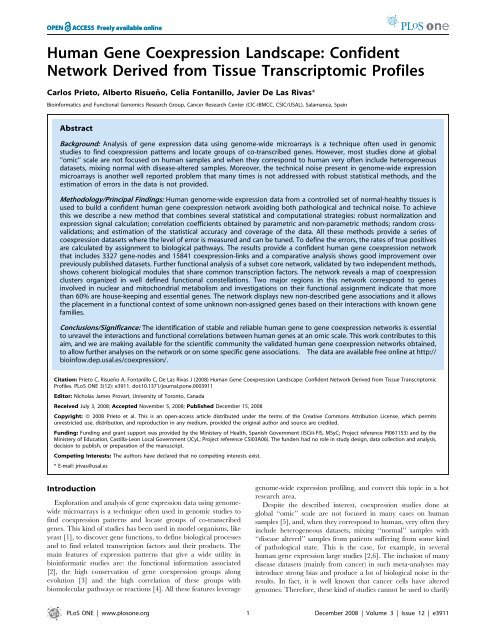Alberto Risueño Pérez - Gredos - Universidad de Salamanca
Alberto Risueño Pérez - Gredos - Universidad de Salamanca
Alberto Risueño Pérez - Gredos - Universidad de Salamanca
You also want an ePaper? Increase the reach of your titles
YUMPU automatically turns print PDFs into web optimized ePapers that Google loves.
Human Gene Coexpression Landscape: Confi<strong>de</strong>nt<br />
Network Derived from Tissue Transcriptomic Profiles<br />
Carlos Prieto, <strong>Alberto</strong> <strong>Risueño</strong>, Celia Fontanillo, Javier De Las Rivas*<br />
Bioinformatics and Functional Genomics Research Group, Cancer Research Center (CIC-IBMCC, CSIC/USAL), <strong>Salamanca</strong>, Spain<br />
Abstract<br />
Background: Analysis of gene expression data using genome-wi<strong>de</strong> microarrays is a technique often used in genomic<br />
studies to find coexpression patterns and locate groups of co-transcribed genes. However, most studies done at global<br />
‘‘omic’’ scale are not focused on human samples and when they correspond to human very often inclu<strong>de</strong> heterogeneous<br />
datasets, mixing normal with disease-altered samples. Moreover, the technical noise present in genome-wi<strong>de</strong> expression<br />
microarrays is another well reported problem that many times is not addressed with robust statistical methods, and the<br />
estimation of errors in the data is not provi<strong>de</strong>d.<br />
Methodology/Principal Findings: Human genome-wi<strong>de</strong> expression data from a controlled set of normal-healthy tissues is<br />
used to build a confi<strong>de</strong>nt human gene coexpression network avoiding both pathological and technical noise. To achieve<br />
this we <strong>de</strong>scribe a new method that combines several statistical and computational strategies: robust normalization and<br />
expression signal calculation; correlation coefficients obtained by parametric and non-parametric methods; random crossvalidations;<br />
and estimation of the statistical accuracy and coverage of the data. All these methods provi<strong>de</strong> a series of<br />
coexpression datasets where the level of error is measured and can be tuned. To <strong>de</strong>fine the errors, the rates of true positives<br />
are calculated by assignment to biological pathways. The results provi<strong>de</strong> a confi<strong>de</strong>nt human gene coexpression network<br />
that inclu<strong>de</strong>s 3327 gene-no<strong>de</strong>s and 15841 coexpression-links and a comparative analysis shows good improvement over<br />
previously published datasets. Further functional analysis of a subset core network, validated by two in<strong>de</strong>pen<strong>de</strong>nt methods,<br />
shows coherent biological modules that share common transcription factors. The network reveals a map of coexpression<br />
clusters organized in well <strong>de</strong>fined functional constellations. Two major regions in this network correspond to genes<br />
involved in nuclear and mitochondrial metabolism and investigations on their functional assignment indicate that more<br />
than 60% are house-keeping and essential genes. The network displays new non-<strong>de</strong>scribed gene associations and it allows<br />
the placement in a functional context of some unknown non-assigned genes based on their interactions with known gene<br />
families.<br />
Conclusions/Significance: The i<strong>de</strong>ntification of stable and reliable human gene to gene coexpression networks is essential<br />
to unravel the interactions and functional correlations between human genes at an omic scale. This work contributes to this<br />
aim, and we are making available for the scientific community the validated human gene coexpression networks obtained,<br />
to allow further analyses on the network or on some specific gene associations. The data are available free online at http://<br />
bioinfow.<strong>de</strong>p.usal.es/coexpression/.<br />
Citation: Prieto C, <strong>Risueño</strong> A, Fontanillo C, De Las Rivas J (2008) Human Gene Coexpression Landscape: Confi<strong>de</strong>nt Network Derived from Tissue Transcriptomic<br />
Profiles. PLoS ONE 3(12): e3911. doi:10.1371/journal.pone.0003911<br />
Editor: Nicholas James Provart, University of Toronto, Canada<br />
Received July 3, 2008; Accepted November 5, 2008; Published December 15, 2008<br />
Copyright: ß 2008 Prieto et al. This is an open-access article distributed un<strong>de</strong>r the terms of the Creative Commons Attribution License, which permits<br />
unrestricted use, distribution, and reproduction in any medium, provi<strong>de</strong>d the original author and source are credited.<br />
Funding: Funding and grant support was provi<strong>de</strong>d by the Ministery of Health, Spanish Government (ISCiii-FIS, MSyC; Project reference PI061153) and by the<br />
Ministery of Education, Castilla-Leon Local Government (JCyL; Project reference CSI03A06). The fun<strong>de</strong>rs had no role in study <strong>de</strong>sign, data collection and analysis,<br />
<strong>de</strong>cision to publish, or preparation of the manuscript.<br />
Competing Interests: The authors have <strong>de</strong>clared that no competing interests exist.<br />
* E-mail: jrivas@usal.es<br />
Introduction<br />
Exploration and analysis of gene expression data using genomewi<strong>de</strong><br />
microarrays is a technique often used in genomic studies to<br />
find coexpression patterns and locate groups of co-transcribed<br />
genes. This kind of studies has been used in mo<strong>de</strong>l organisms, like<br />
yeast [1], to discover gene functions, to <strong>de</strong>fine biological processes<br />
and to find related transcription factors and their products. The<br />
main features of expression patterns that give a wi<strong>de</strong> utility in<br />
bioinformatic studies are: the functional information associated<br />
[2], the high conservation of gene coexpression groups along<br />
evolution [3] and the high correlation of these groups with<br />
biomolecular pathways or reactions [4]. All these features leverage<br />
genome-wi<strong>de</strong> expression profiling, and convert this topic in a hot<br />
research area.<br />
Despite the <strong>de</strong>scribed interest, coexpression studies done at<br />
global ‘‘omic’’ scale are not focused in many cases on human<br />
samples [5], and, when they correspond to human, very often they<br />
inclu<strong>de</strong> heterogeneous datasets, mixing ‘‘normal’’ samples with<br />
‘‘disease altered’’ samples from patients suffering from some kind<br />
of pathological state. This is the case, for example, in several<br />
human gene expression large studies [2,6]. The inclusion of many<br />
disease datasets (mainly from cancer) in such meta-analyses may<br />
introduce strong bias and produce a lot of biological noise in the<br />
results. In fact, it is well known that cancer cells have altered<br />
genomes. Therefore, these kind of studies cannot be used to clarify<br />
PLoS ONE | www.plosone.org 1 December 2008 | Volume 3 | Issue 12 | e3911
















